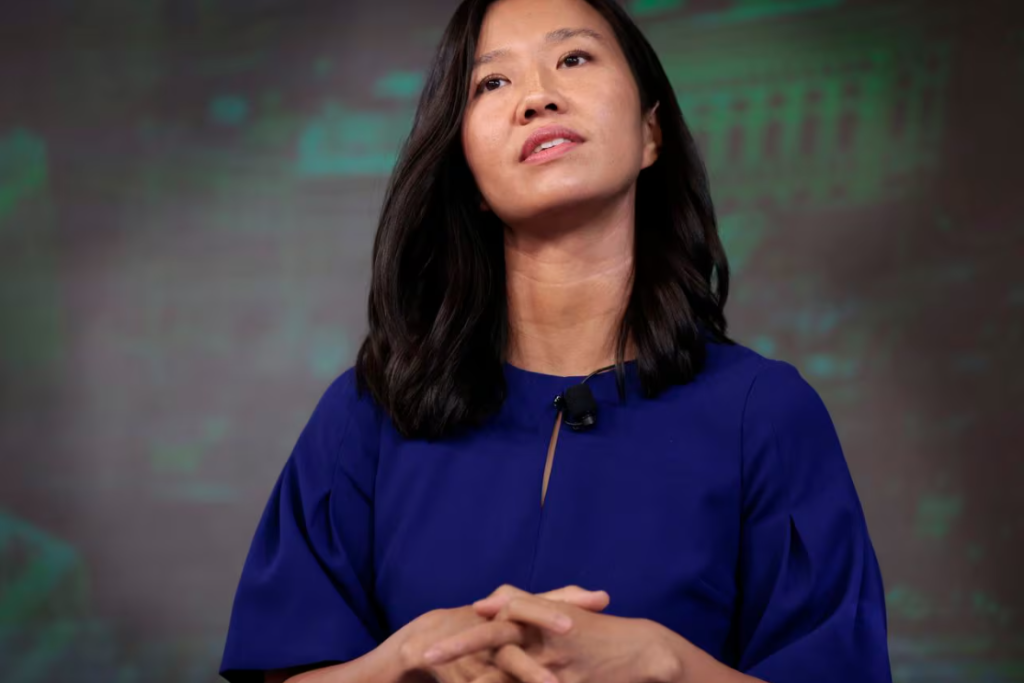【中美创新时报2024年3月21日波士顿讯】(记者温友平编译)根据对专家的采访以及波士顿公共卫生委员会周三发布的一份报告,在过去十年中,波士顿人变得更加悲伤和焦虑,青少年、有色人种和 LGBQ+ 人群的痛苦率更高。《波士顿环球报》记者菲利斯·J·弗雷尔(Felice J. Freyer )和通讯员玛蒂·考(Maddie Khaw)对此作了下述报道。
这份长达 99 页的报告根据调查、死亡数据和医院数据显示,从 2015 年到 2021 年,持续的负面情绪有所增加。这份心理健康报告是题为《2024 年波士顿健康》系列报告的第一部分。
该报告是在周三(3月20日)上午的新闻发布会上发布的,会上,市长吴弭(Michelle Wu )以及卫生和教育官员描述了如何部署 2100 万美元的联邦拨款来改善学生的心理健康。大部分资金来自《2021 年美国救援计划法案》,即被称为 ARPA 的大流行经济刺激法。
“波士顿,我们遇到了问题,”方济会儿童医院院长约瑟夫·米切尔博士说,该医院是一家位于布莱顿的机构,为有复杂健康需求的儿童和青少年提供服务。
米切尔在约瑟夫·李 K-8 学校举行的新闻发布会上发表讲话,指出了有关全国性儿科行为健康危机的“发人深省的事实”:他说,美国五分之一的儿童患有焦虑和抑郁,并且因自杀而需要紧急就诊 ,疫情期间,“某些人群”的尝试次数增加了 50%。
米切尔说:“我们正处于一场流行病之中,我们面临着失去一代孩子的风险。”
该市公共卫生专员比索拉·奥吉库图 (Bisola Ojikutu) 博士表示,虽然报告中的数据可以追溯到 2021 年,但“如果这种趋势在随后几年持续下去,我不会感到惊讶”。
奥吉库图说,这场大流行造成了广泛的心理健康问题,但危机早些时候就开始恶化。她说:“这种情况早在 COVID-19 之前就已经发生过,而且现在已经加剧。”
布鲁克林儿童和青少年精神病学家伊丽莎白·蔡尔兹博士确认,根据她的“实地”经验,自 2021 年以来,儿童的心理健康状况没有改善。“我们仍在应对这一流行病的影响,”她说。
美国疾病控制和预防中心的青少年风险行为调查的数据对高中生的心理健康状况提出了尤为严峻的看法。2021 年,44% 的波士顿公立高中学生表示,他们在两周或更长时间内每天都感到悲伤或绝望,高于 2015 年的 27%,其中女性、拉丁裔和 LGBQ+ 学生的比例更高。 考虑或计划自杀的青少年人数有所增加,但企图自杀的人数却没有增加。 但黑人和拉丁裔青年的自杀未遂率高于白人青年。
查尔兹说,学校关闭期间,孩子们与同龄人分离,错过了社会发展的重要方面,并遭受了学习损失,这阻碍了他们的乐观、自信和使命感。她说,修复这一切需要多年的努力,包括保险公司不愿意支付的长期心理治疗费用。
波士顿公立学校总监玛丽·斯基珀 (Mary Skipper) 表示,这场流行病对有色人种社区的影响尤为严重,并加剧了粮食不安全、收入差距和住房等现有问题。 她说,与此同时,社交媒体增加了年轻人的孤立感和消极情绪。
在成年人中,悲伤并不常见,但也有类似的增加。波士顿行为风险因素监测系统每隔一年进行一次电话调查,发现在过去 30 天中感到悲伤超过 15 天的成年人比例从 2015 年的 12% 飙升至 2021 年的 17%,其中 女性、拉丁裔成年人和 LGBTQ+ 成年人的比率。
最不可能报告持续悲伤的是在美国生活了 10 年或更短时间的外国出生的成年人。
按社区细分表明收入较低是其中一个原因。居住在查尔斯敦、马塔潘、罗克斯伯里和奥尔斯顿-布莱顿的人们持续悲伤的比例最高,而后湾、市中心、灯塔山、北区和西区的比例最低。
波士顿成年人的焦虑情绪也在上升。报告在过去 30 天内至少有 15 天感到焦虑、担心或紧张的百分比从 2015 年的 22% 增加到 2021 年的 27%。白人女性成年人的焦虑率高于亚洲、黑人或拉丁裔女性。
不足为奇的是,超过一半的无家可归的成年人经历了持续的焦虑,是有屋顶的人比例的两倍。
近四分之三的成年人表示,他们会在情绪危机期间寻求治疗。尽管如此,近十分之一的人曾想咨询心理健康专业人士,但由于费用而未能实现。
在 2021 年的高中生中,43% 的人表示,他们在感到悲伤、空虚、绝望或愤怒时得到了所需的帮助。
马萨诸塞州心理健康协会主席兼首席执行官丹娜·莫奇在接受电话采访时表示,自2021年以来,对心理健康服务的需求有所放缓,但仍高于大流行前,学校正在应对更严重的行为问题。
莫奇说:“在大流行背景下出现的这种精神健康流行病的解决尾巴比大流行本身更长。” “我们现在正处于解决问题的时期。”
在周三的新闻发布会上,官员们介绍了一系列旨在增强青少年心理健康资源的计划,其中大部分已经启动。其中包括波士顿公立学校、麻省大学波士顿分校、波士顿大学、布朗大学和其他大学之间耗资 580 万美元的合作伙伴关系,以培养 200 名学校心理学、学校咨询和社会工作学生为波士顿青少年服务;未来四年拨款 400 万美元,培训 37 名非专业卫生工作者、护士和社会工作者,为与州儿童福利系统有联系或需要早期社交和情感发展的四岁以下黑人和拉丁裔儿童提供支持;250万美元用于扩大方济会儿童医院的一项计划,该计划将社会工作者和精神科医生安置在波士顿公立学校。其中大部分由 ARPA 资助,另外还有美国药物滥用和心理健康服务管理局以及美国教育部的资助。
吴弭市长表示,利用 ARPA 来实施这一举措“有点不寻常”。尽管许多城市使用 ARPA 资金来“暂时填补漏洞或填补空白”,吴弭表示,心理健康倡议表明“这些资金可以带来更多可能”。
吴弭说,关键基础设施不仅仅意味着道路、桥梁和其他有形的发展,还意味着在学校和社区内建立一支关心人们心理健康的劳动力队伍。 “这是为了建立这些联系,为我们的社区赋权和投资,”她说。 “这将成为全国其他地区的典范,并且肯定会为子孙后代带来改变。”
约瑟夫·李 K-8 学校 (Joseph Lee K-8 School) 的八年级学生莱赫拉·马丁内斯 (Leihla Martinez) 表示,自从与学校的社会工作者一起工作以来,她已经成为一个更好的学生和人。 她说,以前她倾向于“压抑”自己的情绪。
“我们需要的是鼓励分享我们的故事。我们需要成年人让我们感到安全,并在我们谈论我们的挑战时愿意倾听,”她说。 “我不认为我需要有人倾诉,但我确实需要。”
题图:周三(20日),波士顿市长吴弭(Michelle Wu)宣布为青少年和家庭的心理和行为健康项目提供资金。CRAIG F. WALKER/GLOBE STAFF
附原英文报道:
More Boston high schoolers are feeling sad and hopeless, data show
A new collection of survey data shows that women, Black, Latinx, and LGBQ+ students as well as those in low-income neighborhoods are especially vulnerable.
By Felice J. Freyer and Maddie Khaw Globe Staff and Globe Correspondent,Updated March 20, 2024
Bostonians have grown sadder and more anxious over the last decade, with rates of distress higher among youth, people of color, and LGBQ+ people, according to interviews with experts and a report released Wednesday by the Boston Public Health Commission.
Drawing from surveys, death data, and hospital data, the 99-page report shows that persistent negative emotions increased from 2015 to 2021. The mental health report is the first installment in a series titled the Health of Boston 2024.
It was released at a press conference Wednesday morning at which Mayor Michelle Wu and health and education officials described how $21 million in federal grants were being deployed to improve student mental health. Most of the money comes from the American Rescue Plan Act of 2021, the pandemic economic stimulus law known as ARPA.
“Boston, we have a problem,” said Dr. Joseph Mitchell, president of Franciscan Children’s Hospital, a Brighton-based agency that serves children and adolescents with complex health needs.
Speaking at the press conference at the Joseph Lee K-8 School, Mitchell pointed to “sobering facts” about a nationwide pediatric behavioral health crisis: One in five children in the US suffers from anxiety and depression, he said, and emergency visits for suicide attempts went up 50 percent “for some populations” during the pandemic.
“We are in the middle of an epidemic, and we risk losing a generation of kids,” Mitchell said.
Dr. Bisola Ojikutu, the city’s commissioner of public health, said that while the report’s numbers date to 2021, “It would not be surprising to me if that trend continues” in subsequent years.
The pandemic contributed to widespread mental health difficulties, but the crisis was festering earlier, Ojikutu said. “This is something that preceded COVID-19 and has been exacerbated,” she said.
Dr. Elizabeth Childs, a Brookline child and adolescent psychiatrist, affirmed that based on her “on the ground” experience, children’s mental health has not improved since 2021. “We are still dealing with the fallout of the pandemic,” she said.
Data from the CDC’s Youth Risk Behavior Survey provides an especially grim view of the mental health of high schoolers. In 2021, 44 percent of Boston public high school students said they felt sad or hopeless every day for two weeks or more, up from 27 percent in 2015, with higher rates among female, Latinx, and LGBQ+ students. The number of youths who considered or planned a suicide went up, but not the number who attempted suicide. But Black and Latinx youth had higher rates of attempted suicide than white youths.
Separated from their peers while schools were closed, children missed out on important aspects of their social development and suffered learning loss that has hampered their optimism, self-confidence, and sense of purpose, Childs said. Repairing all this, she said, is going to take years of hard work, including the long-term psychotherapy that insurers don’t want to pay for.
The pandemic disproportionately affected communities of color and heightened existing problems with food insecurity, income disparities, and housing, said Mary Skipper, Boston Public Schools superintendent. At the same time, social media increased feelings of isolation and negativity among young people, she said.
Among adults, sadness was not as common, but showed a similar increase. The Boston Behavioral Risk Factor Surveillance System, an every-other-year phone survey, found that the percentage of adults who felt sad for more than 15 days out of the previous 30 spiked from 12 percent in 2015 to 17 percent in 2021, with higher rates among women, Latinx adults, and LGBTQ+ adults.
Those least likely to report persistent sadness were foreign-born adults who have lived in the United States for 10 years or fewer.
A breakdown by neighborhood suggests that lower income plays a role. People living in Charlestown, Mattapan, Roxbury, and Allston-Brighton had the highest rates of persistent sadness, while the lowest rates were found in Back Bay, Downtown, Beacon Hill, the North End, and the West End.
Anxiety is also on the upswing among Boston’s adults. The percentage who reported feeling anxious, worried, or tense for at least 15 days in the previous 30 days increased from 22 percent in 2015 to 27 percent in 2021. White female adults had higher rates of anxiety than Asian, Black, or Latinx women.
Not surprisingly, more than half of homeless adults experienced persistent anxiety, double the proportion of people with roofs over their heads.
Nearly three-quarters of adults said they would seek therapy during an emotional crisis. Still, nearly 1 in 10 had wanted to consult with a mental health professional but could not because of cost.
Among high school students in 2021, 43 percent said they had received the help they needed when feeling sad, empty, hopeless, or angry.
Danna Mauch, president and CEO of the Massachusetts Association for Mental Health, said in a phone interview that since 2021, demand for mental health services has moderated but remains higher than before the pandemic, and schools are contending with worse behavioral problems.
”This mental health epidemic that arose in the context of the pandemic has a longer tail of resolution than the pandemic itself,” Mauch said. “We’re in that period of resolution now.”
Officials at Wednesday’s press conference described an array of programs intended to bolster mental health resources for youngsters and teens, most of which have started. Among them were a $5.8 million partnership between Boston Public Schools, UMass Boston, Boston University, Brown University, and others to prepare 200 school psychology, school counseling, and social work students to serve Boston youth; $4 million over the next four years to train 37 lay health workers, nurses, and social workers to support Black and Latinx children under four years old who are connected to the state child welfare system or in need of early social and emotional development; and $2.5 million to expand a program at Franciscan Children’s that places social workers and psychiatrists in Boston public schools. Most were funded by ARPA, with additional grants from the US Substance Abuse and Mental Health Services Administration and US Department of Education.
Mayor Wu said the use of ARPA for this initiative is “a little bit unusual.” While many cities used ARPA funds to “plug holes or fill gaps temporarily,” Wu said the mental health initiative shows that “more is possible with those dollars.”
Critical infrastructure, Wu said, doesn’t just mean roads, bridges, and other tangible developments, but also building a workforce that cares for people’s mental health within their own schools and communities. “It is about building those connections, empowering and investing in our community,” she said. “This is going to be a model for the rest of the country and certainly will make a difference for generations to come.”
Leihla Martinez, an eighth grader at the Joseph Lee K-8 School, said she has become a better student and person since working with the social worker at her school. Before, she said, she tended to “bottle up” her emotions.
“What we need is encouragement to share our story. We need adults that can make us feel safe and will listen when we talk about our challenges,” she said. “I didn’t think I needed someone to talk to, but I did.”

